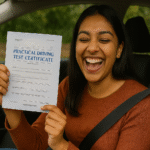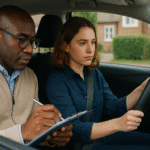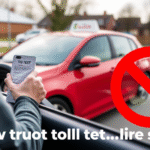Effective Strategies for How to Get Practical Driving Test Fast
If you want to take your practical driving test quickly and efficiently, there are several strategies you can implement to speed up the process. Getting your driving license is a significant milestone, and knowing how to navigate the requirements can save you considerable time and stress. Below are some effective methods to help you achieve your goal of a fast practical driving test.
First, ensure you have a strong grasp on the fundamentals of driving. A solid understanding of road rules, vehicle controls, and safety measures is crucial. If you are starting from scratch or need a refresher, consider the following tips:
- Take a Driver’s Education Course: Enroll in a reputable driving school that offers a comprehensive driver’s education course. This education is invaluable and can help you pass the practical test more quickly.
- Practice Regularly: The more you drive, the more comfortable you’ll feel behind the wheel. Strive for at least 20 hours of practice before your test.
- Simulate Test Conditions: Preparation is key. If possible, practice the driving test routes in your area, mimicking what will happen on the day of your test.
Prepare all the necessary documentation well in advance. Missing paperwork can delay your test, so double-check that you have everything in order. Here’s a quick checklist of documents to gather:
- Valid learner’s permit
- Proof of identity
- Proof of residency
- Completion certificate from your driver’s education course (if applicable)
Another essential aspect is to book your driving test appointment at the right time. To do this, consider the following:
- Choose Off-Peak Times: When booking your test, aim for times that are likely less busy, such as mid-week mornings. This can lead to reduced wait times.
- Schedule Early: Slots can fill up quickly, especially during peak times. As soon as you feel ready, book your test to secure a convenient time.
Familiarity with the vehicle is also critical. You should feel comfortable driving the car you intend to use for the test. If you plan to borrow a vehicle, schedule some practice time with it beforehand. Here’s what to keep in mind:
- Check Vehicle Requirements: Ensure the car is roadworthy and meets all necessary requirements. It should have valid registration, functioning lights, and seatbelts.
- Know Your Vehicle: Be comfortable with your vehicle’s controls. Understand how to operate the headlights, windshield wipers, and horn before your test.
In the days leading up to your practical driving test, practice relaxation techniques to help ease any anxiety. Nervousness can hinder performance. Here are some methods to consider:
- Deep Breathing: Calm your nerves by taking slow, deep breaths before and during the test.
- Visualize Success: Picture yourself passing the test confidently. Visualization can boost your confidence and reduce anxiety.
On the day of your test, arrive early. This gives you ample time to gather your thoughts and settle in. Consider these tips:
- Plan Your Route: Know how to get to the testing location to avoid any last-minute rush.
- Bring All Necessary Documents: Pack everything you need to avoid unnecessary stress.
During the test, maintain a calm demeanor and focus on what you have practiced. Stay aware of your surroundings, follow traffic laws, and communicate effectively with your examiner. Remember to:
- Make Safe Decisions: Always prioritize safety, whether it’s yielding to pedestrians or following speed limits.
- Use Proper Signaling: Communicate your intentions clearly with turn signals and brake lights.
By preparing thoroughly, practicing regularly, and maintaining a calm mindset, you can significantly expedite the process of getting your practical driving test. Implement these strategies, and you’ll be on your way to obtaining your driving license efficiently and confidently.
Understanding the Practical Driving Test Requirements
When preparing for the practical driving test, understanding the requirements is crucial for success. Knowing what to expect can help reduce anxiety and increase confidence as you step into the driver’s seat. Let’s break down the essential components that you need to be aware of.
Eligibility Criteria
The first step to taking your practical driving test is ensuring you meet the eligibility criteria. Different regions may have varying rules, but common factors include:
- Minimum Age: Most places require you to be at least 17 years old.
- Valid Learner’s Permit: You must hold a valid learner’s permit for a specific period, often ranging from six months to a year.
- Driving Experience: Some locations demand a minimum of 20-50 hours of driving experience.
Documents Required
Before you can even sit for the practical driving test, it’s important to gather necessary documents. Typically, these may include:
- Your valid learner’s permit
- Proof of identity (like a passport or birth certificate)
- Proof of residency (utility bill or bank statement)
- A completed application form
The Vehicle Requirements
Another significant aspect of the test is ensuring that the vehicle you’ll be using meets specific requirements. Usually, the vehicle must:
- Be registered and insured
- Have valid inspection stickers (if applicable)
- Be in good working condition (brakes, lights, turn signals, etc.)
- Have functioning seat belts for all passengers
Test Format
Understanding the format of the driving test can ease some of your worries. Typically, the exam consists of two main parts:
- Basic Skills Test: This includes tasks like parallel parking, three-point turns, and backing up straight. You’ll be scored on how well you execute these maneuvers.
- Road Test: This part involves real-world driving. You’ll be evaluated on your ability to follow traffic signals, observe speed limits, and demonstrate safe driving practices.
Evaluation Criteria
Your performance during the test will be evaluated based on several criteria. Each region may have a slightly different scoring system, but common aspects include:
- Observation Skills: Checking mirrors and looking for pedestrians.
- Control of the Vehicle: Smooth steering, braking, and acceleration.
- Adherence to Traffic Laws: Following signals, stop signs, and speed limits.
- Safe Driving Practices: Maintaining a safe distance from other vehicles and using turn signals.
Tips for Success
To increase your chances of passing the practical driving test, consider the following strategies:
- Practice with a licensed adult regularly.
- Know the testing route if possible; familiarize yourself with common roads.
- Stay calm and focused; nerves can lead to mistakes.
- Listen to your examiner’s instructions carefully and ask for clarification if needed.
Common Mistakes to Avoid
Being aware of common pitfalls can also help you succeed. Here are mistakes to avoid during your test:
- Failing to check blind spots before changing lanes.
- Not using turn signals appropriately.
- Driving too fast or too slow for the conditions.
- Ignoring road signs and signals.
Ultimately, understanding the framework of the practical driving test requirements can lead to greater confidence on the day of the exam. Prepare thoroughly and manage your time wisely. Remember, with dedication and practice, you can pass your practical driving test and earn your driver’s license!
Common Mistakes That Slower Test Candidates Make
When preparing for a driving test, it’s important to identify and avoid common mistakes that can hinder your performance. Candidates who tend to struggle often overlook specific areas, creating unnecessary hurdles for themselves. Here’s a breakdown of these frequent errors and tips on how to overcome them.
Misunderstanding Testing Procedures
A significant number of candidates fail to fully grasp the testing procedures. This can lead to confusion during the test and reduce their overall performance. Familiarity with the rules and steps of the test can greatly improve your confidence. To prevent misunderstandings:
- Study the driving handbook thoroughly.
- Take part in a mock driving test.
- Ask your instructor for clarification on any aspects of the test.
Poor Vehicle Control
Another common mistake is a lack of control over the vehicle. Candidates who struggle with vehicle control might hesitate during maneuvers, such as lane changes or parking, which raises concerns for examiners. To enhance your vehicle handling, consider the following:
- Practice basic maneuvers daily.
- Use a variety of vehicles to become adaptable.
- Work on your coordination: ensure you can smoothly operate the clutch, accelerator, and brakes.
Lack of Situational Awareness
Being aware of your surroundings while driving is crucial. Test candidates often focus too intently on the road directly ahead, neglecting side mirrors and surrounding vehicles. This can lead to mistakes, such as improper lane changes or failure to spot pedestrians. To improve your situational awareness:
- Practice scanning the road every few seconds.
- Be mindful of the traffic around you, including pedestrians and cyclists.
- Look ahead and anticipate what other drivers might do.
Excessive Nervousness
Nervousness can greatly affect your driving ability during the test. If you feel anxious, you may forget essential skills or make simple mistakes. To manage nervousness, try these techniques:
- Practice deep breathing exercises before your test.
- Visualize yourself successfully completing the test.
- Remain positive and remind yourself of your preparation efforts.
Inadequate Understanding of Road Signs and Rules
Many slower candidates tend to struggle with understanding road signs and the laws that accompany them. Misinterpreting a sign can lead to a failed test. To boost your knowledge:
- Memorize common road signs and their meanings.
- Review traffic rules regularly.
- Take practice quizzes to test your knowledge.
Inefficient Parallel Parking Skills
Many candidates find parallel parking particularly tricky, leading to anxiety during the test. Testers commonly assess this skill, and failing to perform well can be detrimental. To refine your parallel parking technique:
- Practice in varied environments with different parking spaces.
- Use cones to mark spaces and simulate real-life situations.
- Focus on your mirrors to better gauge your surroundings.
Ignoring Pre-Test Preparation
One of the most significant mistakes is neglecting preparation before the driving test. This includes everything from getting a good night’s sleep to ensuring your vehicle is roadworthy. Consider this checklist:
| Preparation Step | Importance |
|---|---|
| Get adequate rest before the test | Improves focus and reduces anxiety |
| Inspect your vehicle | Ensures it meets safety requirements |
| Practice with a qualified instructor | Builds skills and confidence |
| Arrive early to the test center | Reduces stress from rushing |
By becoming aware of these common mistakes, you can take proactive steps to improve your chances of passing the driving test. Focus on honing your skills, increasing your knowledge, and managing anxiety, and you’ll be well on your way to success on test day.
Time Management Techniques for Efficient Driving Practice
Mastering the art of driving requires not just practice but a well-structured approach to your time management. Using effective time management techniques for driving practice can help you make the most of each session while ensuring that you are consistently improving your skills. Here are some valuable strategies you can implement.
Set Clear Goals
Before you even start practicing, it’s essential to define your objectives. A focused approach will help you navigate your time effectively. Here are some goal types you may consider:
- Skill Development: Concentrate on specific skills such as parallel parking or highway merging.
- Distance Covered: Set a goal for how many miles you want to drive in a session.
- Duration: Establish a time frame for each practice session—whether it’s 30 minutes or two hours.
Create a Weekly Schedule
Designing a weekly driving practice schedule will ensure you allocate time specifically for practice without overlap with your other responsibilities. This reduces the chances of skipping a session due to forgetfulness or poor planning. Here’s a simple format:
| Day | Time | Practice Focus |
|---|---|---|
| Monday | 4 PM – 5 PM | City Driving |
| Wednesday | 5 PM – 6 PM | Highway Merging |
| Friday | 4 PM – 6 PM | Parking Skills |
With this example layout, you can easily visualize your practice sessions and adjust as needed based on your availability or progress.
Prioritize Practice Areas
Not all roads or driving scenarios are created equal. By prioritizing specific areas that require improvement, you can better utilize your time. Identify the driving environments you’re less comfortable in and focus on those:
- Residential Areas
- Busy Intersections
- Highways
- Parking Lots
Devote more time to areas where you need extra help or exposure. This targeted practice can drastically enhance your confidence.
Utilize Technology
Many apps and tools can assist you in managing your driving practice efficiently. Here are a few types to consider:
- Driving Simulators: These can help you practice your skills virtually and break the monotony.
- GPS Tools: Use apps like Google Maps to discover new routes while practicing defensive driving.
- Progress Tracking: Use an app to record your hours, skills focused on, and areas you still need to improve.
Stay Flexible
While having a plan is essential, staying flexible can also enhance your practice sessions. Life can often get in the way, and unforeseen circumstances may affect your schedule. Here are some tips for maintaining flexibility:
- If you miss a session, reschedule it as soon as possible.
- Don’t be afraid to swap focus areas based on how you’re feeling that day.
- Celebrate small wins to stay motivated, even if the day’s session didn’t go as planned.
Seek Feedback
After each driving practice session, it’s beneficial to get feedback. Whether from a qualified instructor or a friend who can observe your skills, this will provide you with perspectives on your improvements and areas that still need work. Regular feedback should be a pivotal part of your training regime.
By implementing these time management techniques in your driving practice, you will find that your progress accelerates. Not only will you become a more competent driver, but you’ll also develop skills that will serve you well on the road for years to come. Remember, the more efficient you are with your time, the more success you will achieve in mastering your driving abilities.
Tips for Staying Calm and Focused During Your Driving Test
Feeling anxious before your driving test is completely normal. However, staying calm and focused is key to performing your best. Here are some practical tips to help you manage your nerves and ace that test.
First, preparation is vital. The more you know what to expect, the more comfortable you’ll feel. Familiarize yourself with the roads and routes typically used in driving tests in your area. This includes head checks, roundabouts, and other common traffic situations. Practicing these maneuvers can give you the confidence boost you need. Consider the following:
- Take multiple practice tests in various conditions, such as heavy traffic or different times of day.
- Know the test requirements and the specific maneuvers you will have to perform.
- Practice with a friend or a driving instructor who can give you constructive feedback.
Next, focus on your physical and mental well-being leading up to the test. Good sleep and nutrition can significantly impact your performance. Here are some key strategies:
- Get a good night’s sleep before your test. Aim for at least 7-8 hours to ensure you’re well-rested.
- Eat a healthy meal before the test, opting for something that balances carbohydrates with protein. This will help maintain your energy levels.
- Stay hydrated, but avoid excessive caffeine which may increase anxiety.
If you find yourself feeling overwhelmed on the day of the test, several relaxation techniques can help center your mind. Consider implementing the following:
- Deep breathing exercises: Take slow, deep breaths to calm your nervous system. Inhale deeply for four counts, hold for four, and exhale for six.
- Visualization: Imagine yourself driving confidently and successfully passing the test. This mental practice can help set a positive tone.
- Positive affirmations: Repeat calming and positive statements to yourself, such as “I am ready for this” or “I can do this.”
Dress comfortably for your test. Wearing something that you feel good in can boost your confidence and help you feel more at ease. Make sure your clothing doesn’t restrict your movement in the car.
Arriving early can help alleviate last-minute stress. Find the testing center in advance and aim to arrive at least 15 minutes early. This time allows you to settle down and gather your thoughts. Use this time to review any last-minute notes or to simply breathe and relax.
During the test, keep your focus on the road. Avoid distractions by turning off your phone or asking friends and family not to communicate with you until after the test. Remember, the examiner is not there to fail you; they want to see you succeed. Maintain a steady pace and don’t rush through your maneuvers.
If you feel yourself becoming anxious while driving, employ grounding techniques. Focus on your surroundings; notice the trees, the sky, or other vehicles. This can bring your attention back to the present moment and help reduce anxiety.
After your driving test, regardless of the outcome, treat yourself kindly. If you pass, celebrate this accomplishment and reward yourself. If you don’t, remind yourself that many people require multiple attempts before passing, and it’s all part of the learning process. Consider the feedback you received and what you can improve for next time.
To sum up, staying calm and focused during your driving test can be achieved by preparation, proper nutrition, relaxation techniques, and positive thinking. Remember that each test is a stepping stone towards becoming a proficient driver. Stay confident in your abilities!
Key Takeaway:
Getting ready for your practical driving test can be a daunting process, but with the right strategies and knowledge, you can pass your test faster and with more confidence. One key takeaway from this article is the importance of preparation and practice, which can significantly speed up your journey to obtaining your driving license. Understanding the practical driving test requirements is essential. Knowing what the test entails—from vehicle checks to specific driving maneuvers—helps you focus your practice sessions on what truly matters.
Identifying and avoiding common mistakes that can slow you down is vital. Candidates often panic over simple tasks or forget to check mirrors, which can lead to unnecessary errors. By recognizing these frequent pitfalls, you can work on correcting those habits before your test, allowing for a smoother and quicker examination process.
Effective time management techniques come into play when planning your driving practice. Structured practice sessions that target specific skills not only improve your driving abilities but also help manage your time better. Instead of random practice, set small goals for each session, focusing on areas where you need improvement. This targeted approach not only makes your practice more efficient but also builds your confidence progressively.
Staying calm and focused during your driving test is crucial. Test anxiety can lead to mistakes that might have been avoided. Practice relaxation techniques such as deep breathing and visualization to help keep your nerves in check. Remember, the goal of your driving test is to showcase your competency behind the wheel calmly and effectively.
An organized and focused approach to preparing for your practical driving test makes a world of difference. By understanding the requirements, avoiding common mistakes, managing your practice time efficiently, and maintaining calmness during the test, you increase your chances of passing quickly and confidently. Embrace these strategies, and you’ll be well on your way to earning your driving license in no time.
Conclusion
Achieving a fast and successful practical driving test requires a combination of effective strategies, understanding test requirements, and mastering time management techniques. By familiarizing yourself with the essential requirements of the practical driving test, you can ensure that you focus on the right skills.
Avoiding common mistakes made by slower candidates, such as rushing maneuvers or neglecting essential checks, can significantly improve your chances of passing on your first attempt. Remember, precision is often more valuable than speed. Practicing consistently and dedicating time to each aspect of the driving test will help you build the confidence needed to perform efficiently.
Time management techniques into your practice schedule, such as setting specific goals for each session, can maximize your learning and help you utilize your time effectively. preparation is key to staying calm and focused during your driving test. Techniques like deep breathing, visualization, and positive affirmations can alleviate anxiety and boost your confidence.
With these tips in mind, you can approach your driving test with the knowledge and skills needed to pass quickly. Successful drivers are those who not only know how to drive but also how to manage their time, stay calm under pressure, and avoid common pitfalls. Embrace these strategies, and you’re well on your way to obtaining your driving license in no time.







Leave a Reply